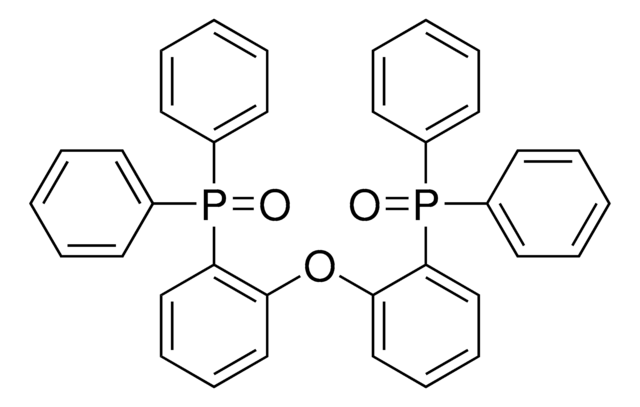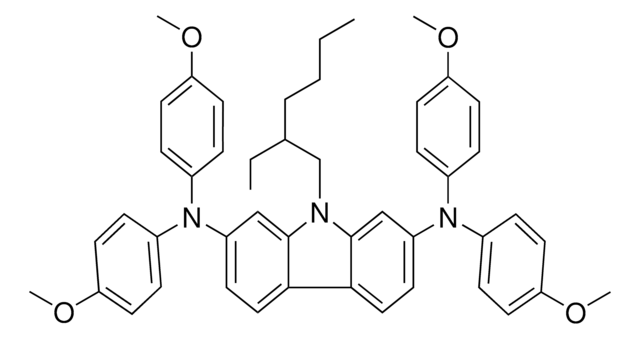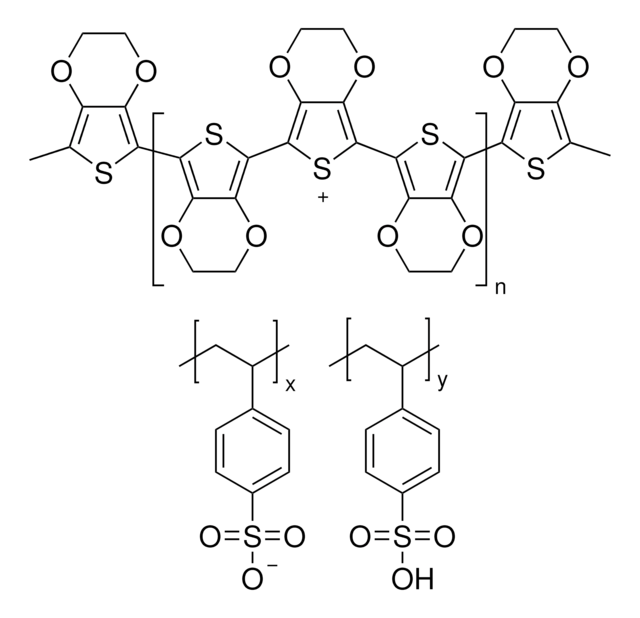907073
PO-T2T
>=99% (HPLC), Mw 909.8 g/mol,
Sinonimo/i:
(1,3,5-Triazine-2,4,6-triyl)tris(benzene-3,1-diyl)tris(diphenylphosphine oxide), 2,4,6-Tris[3-(diphenylphosphinyl)phenyl]-1,3,5-triazine
About This Item
Prodotti consigliati
Nome del prodotto
PO-T2T, >=99% (HPLC),
Grado
sublimed grade (>99% (HPLC))
Descrizione
PL-295, 379 nm (in CH2Cl2)
Stato
solid
PM
Mw 909.8 g/mol
Colore
white
λmax
272 nm in dichloromethane
Energia dell’orbitale
HOMO -6.8 eV
LUMO -2.8 eV
Temperatura di conservazione
15-25°C
Stringa SMILE
[P](=O)(c3cc(ccc3)c4nc(nc(n4)c8cc(ccc8)[P](=O)(c%10ccccc%10)c9ccccc9)c5cc(ccc5)[P](=O)(c7ccccc7)c6ccccc6)(c2ccccc2)c1ccccc1
InChI
RDVGOMWIWCMKAM-UHFFFAOYSA-N
Applicazioni
ITO/MoO3 (3 nm)/ TAPC (35 nm)/CBP:TTM-3NCz (3.0 wt%; (40 nm) and CBP:TTM3PCz (3.0 wt%; 25 nm)/B3PYMPM (10 nm)/PO-T2T (70 nm)/LiF (0.8 nm)/Al (100 nm).
The first Tandem, All-exciplex-based WOLED was constructed using PO-T2T for a device structure configured by two parallel blend layers of mCP/PO-T2T and DTAF/PO-T2T, generating blue and yellow exciplex emission, respectively. The resulting device demonstrates for the first time a tandem, all-exciplex-based white-light OLED (WOLED) with excellent efficiencies ηext: 11.6%, ηc: 27.7 cd/A, and ηp: 15.8 ml/W with CIE(0.29, 0.35) and CRI 70.6 that are nearly independent of EL intensity. The tandem architecture and blend-layer donor/acceptor (1:1) configuration are two key elements that fully utilize the exciplex delay fluorescence, providing a paragon for the use of low-cost, abundant organic compounds en route to commercial WOLEDs.
An efficient action of radical-based OLEDs, whose emission originates from a spin doublet, rather than a singlet or triplet exciton was demonstrated in a study published in Nature.
While the emission process is still spin-allowed in these OLEDs, the efficiency limitations imposed by triplet excitons are circumvented for doublets. Using a luminescent radical emitter, an OLED with maximum external quantum efficiency of 27% at a wavelength of 710nm-the highest reported value for deep-red and infrared LEDs was achieved. In this very efficient OLEDs, selective hole injection into the HOMO and electron injection to the SOMO was achieved imploying TAPC as the hole transport layer, and PO-T2T as the electron transport layer to form the fluorescent doublet excited state with near-unity internal quantum efficiency.
Codice della classe di stoccaggio
13 - Non Combustible Solids
Classe di pericolosità dell'acqua (WGK)
WGK 3
Punto d’infiammabilità (°F)
Not applicable
Punto d’infiammabilità (°C)
Not applicable
Scegli una delle versioni più recenti:
Certificati d'analisi (COA)
Non trovi la versione di tuo interesse?
Se hai bisogno di una versione specifica, puoi cercare il certificato tramite il numero di lotto.
Possiedi già questo prodotto?
I documenti relativi ai prodotti acquistati recentemente sono disponibili nell’Archivio dei documenti.
Articoli
Professor Tokito and Professor Takeda share their new materials, device architecture design principles, and performance optimization protocols for printed and solution-processed, low-cost, highly flexible, organic electronic devices.
Il team dei nostri ricercatori vanta grande esperienza in tutte le aree della ricerca quali Life Science, scienza dei materiali, sintesi chimica, cromatografia, discipline analitiche, ecc..
Contatta l'Assistenza Tecnica.








